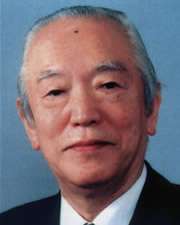Kenichi Honda
| Kenichi Honda | |
|---|---|
 | |
| Born | August 23, 1925 |
| Died | February 26, 2011 (aged 85) |
| Fields | Photoelectrochemistry |
| Alma mater | University of Tokyo |
| Doctoral students | Akira Fujishima |
| Notable awards |
Asahi Prize (1982) Japan Prize (2004) |
Kenichi Honda (本多健一, August 23, 1925 – February 26, 2011) was a Japanese chemist. He made a significant contribution to the discovery and characterization of photocatalytic properties of titanium dioxide (TiO2), for which he shared the 2004 Japan Prize with his former student Akira Fujishima.[1]
Biography
In 1949 Honda received his bachelor's degree in engineering from the University of Tokyo. He then spent several years in France, where he defended a PhD in 1957 at the University of Paris. After returning to Japan he obtained a second doctorate degree, from the University of Tokyo in 1961. He then worked as a lecturer (1965–1975) and professor (1975–1983) at the University of Tokyo and at Kyoto University (1983–1989).[2] In 1989 he moved to the Tokyo Polytechnic University and served as its president in 1996–2004.[1]
Research
In the late 1960s Honda and his doctorate student Akira Fujishima discovered the Honda-Fujishima effect - photocatalytic water decomposition (photolysis) upon exposing a titanium dioxide electrode to strong light. For this discovery, published in 1972,[3][4] Honda and Fujishima received the 2004 Japan Prize.[1]
References
- 1 2 3 Dr. Kenichi Honda. japanprize.jp
- ↑ Honda Kenichi. Encyclopædia Britannica
- ↑ Fujishima, Akira; Honda, Kenichi (7 July 1972). "Electrochemical Photolysis of Water at a Semiconductor Electrode". Nature. 238 (5358): 37–38. PMID 12635268. doi:10.1038/238037a0.
- ↑ The world of titanium dioxide. u-tokyo.ac.jp